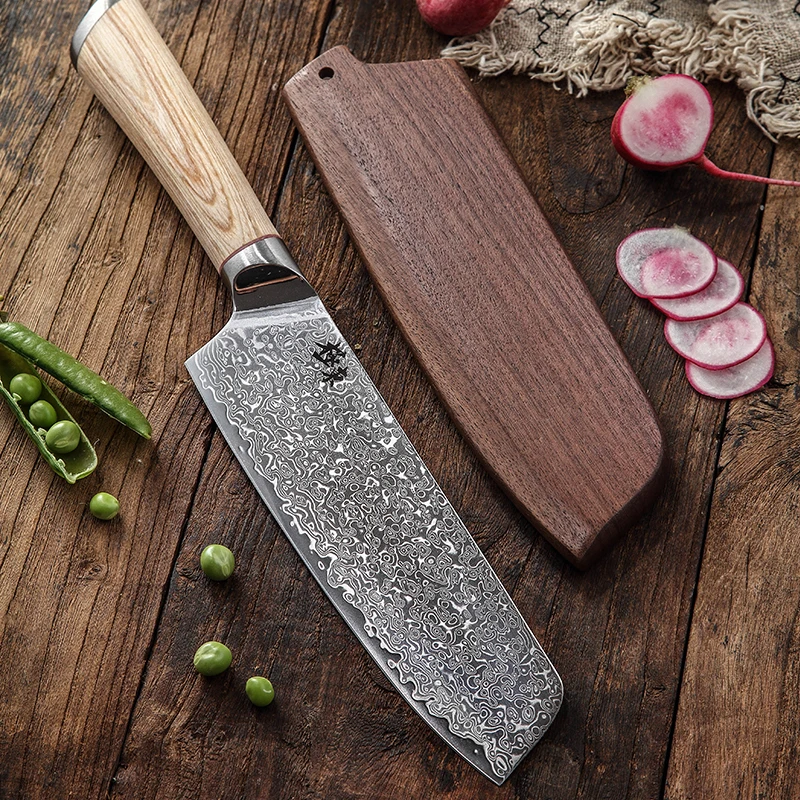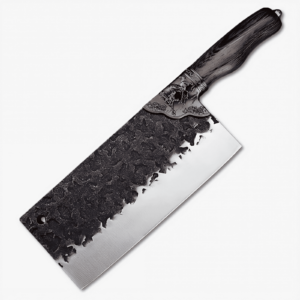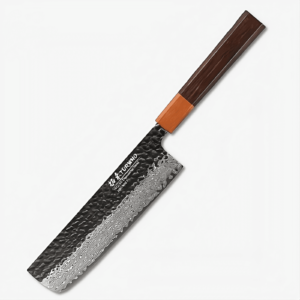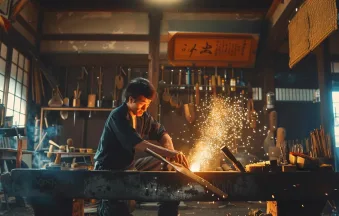Introduction to Japanese Knives
Japanese knives are renowned for their exceptional craftsmanship, sharpness, and precision, which stem from centuries-old sword-making traditions. Unlike many Western knives, which prioritize durability and versatility, Japanese knives are often more specialized, designed with precision in mind for specific culinary tasks. The blades are typically thinner, sharper, and made from harder steel, allowing for cleaner cuts with less effort.
Key Differences Between Japanese and Western Knives
- Blade Material:
- Japanese knives often use high-carbon steel or a combination of softer and harder steels (such as VG-10 or AUS-10). This allows for a razor-sharp edge but requires careful maintenance to prevent chipping or rusting.
- Western knives are generally made of softer stainless steel, making them more durable and easier to sharpen, but they cannot hold as fine of an edge as Japanese knives.
- Maintenance: Japanese blades are more susceptible to chipping and rust, so they require more attention. It’s recommended to hand wash, dry immediately, and store them properly.
- Blade Edge:
- Single-bevel knives (like many Japanese knives) have one sharpened side, creating an incredibly sharp edge that allows for highly precise cuts. This design is ideal for specific tasks such as slicing fish or cutting vegetables in uniform pieces.
- Double-bevel knives (common in Western knives) have a symmetrical edge, making them more versatile but less precise for specialized tasks. They are generally easier to use for people with no professional experience.
- Handle:
- Wa (Japanese) handles are usually made from lightweight wood and are more cylindrical or octagonal in shape. This gives the knife a lighter feel and better control, particularly for precise slicing and cutting.
- Western handles are heavier and ergonomically designed for a comfortable grip, making them easier to wield for heavier, more forceful tasks.
Types of Japanese Knives
1. Cleaver
- Design: A large, rectangular knife with a heavy blade.
- Purpose: Cleavers are perfect for cutting through bones, tough meats, and large vegetables like squash and melons. Unlike the Chinese-style cleaver, which can be used for more delicate slicing, the Japanese cleaver is primarily a butchering tool.
- Best Use: Ideal for heavy-duty kitchen tasks where power and force are needed to break down larger cuts of meat or bone.
-
 Toyo 7″ Stainless Steel Cleaver 中華包丁£42.99
Toyo 7″ Stainless Steel Cleaver 中華包丁£42.99 -
Product on sale
 Saba 8″ Stainless Steel Cleaver 中華包丁Original price was: £64.99.£34.99Current price is: £34.99.
Saba 8″ Stainless Steel Cleaver 中華包丁Original price was: £64.99.£34.99Current price is: £34.99. -
 Tokachi 7.5″ Damascus Steel Cleaver 中華包丁£92.99
Tokachi 7.5″ Damascus Steel Cleaver 中華包丁£92.99
2. Deba
- Design: A thick, heavy knife with a single bevel, ranging from 150mm to 210mm in length.
- Purpose: The Deba is traditionally used in fish butchery, specifically for gutting, filleting, and breaking down whole fish. Its weight and sharpness allow it to cut through fish bones while still being delicate enough for clean cuts of flesh.
- Best Use: If you regularly work with whole fish, a Deba is indispensable. It can also be used for light butchery tasks, like cutting through poultry joints.
3. Fillet/Boning Knife
- Design: A narrow, flexible blade, often double-beveled.
- Purpose: This knife excels at separating meat from bone. The flexible blade contours around bones, making it ideal for filleting fish, boning poultry, and trimming meat.
- Best Use: Ideal for precision work involving fish or meat, such as creating clean fillets or trimming fat and tendons.
4. Gyuto
- Design: A double-bevel, all-purpose knife, typically between 210mm to 270mm in length. It has a slight curve to the edge, allowing for a rocking motion when chopping.
- Purpose: The Gyuto is the Japanese equivalent of a Western chef’s knife and is designed for versatility. It can handle almost any kitchen task, from slicing meat to chopping vegetables, and is a great option for both professionals and home cooks.
- Best Use: If you need one knife that can do almost everything, the Gyuto is the perfect choice. Its balance, sharpness, and adaptability make it the most commonly used knife in Japanese kitchens.
-
Product on sale
 Tenjin 8.5″ Stainless Steel Gyuto Knife 牛刀Original price was: £56.99.£39.99Current price is: £39.99.
Tenjin 8.5″ Stainless Steel Gyuto Knife 牛刀Original price was: £56.99.£39.99Current price is: £39.99. -
Product on sale
 Sakawa 8″ Damascus Steel Gyuto Knife 牛刀Original price was: £56.99.£44.99Current price is: £44.99.
Sakawa 8″ Damascus Steel Gyuto Knife 牛刀Original price was: £56.99.£44.99Current price is: £44.99. -
 Kumozu 8” Damascus Steel Gyuto Knife 牛刀£103.99
Kumozu 8” Damascus Steel Gyuto Knife 牛刀£103.99
5. Kiritsuke
- Design: A long, flat blade with an angled tip, often single-beveled.
- Purpose: A hybrid between the Yanagiba (used for slicing fish) and the Gyuto (used for all-around tasks), the Kiritsuke is a master’s knife in Japanese cuisine. It’s reserved for more skilled chefs due to the challenge of mastering its use.
- Best Use: Ideal for precise cuts in vegetables and slicing fish. The sharp, pointed tip allows for intricate work, while the long blade makes it suitable for slicing meats.
-
Product on sale
 Ebony Grain 8″ Kiritsuke Knife 切り付け包丁Original price was: £43.99.£34.99Current price is: £34.99.
Ebony Grain 8″ Kiritsuke Knife 切り付け包丁Original price was: £43.99.£34.99Current price is: £34.99. -
Product on sale
 Yoshii 8″ Damascus Steel Kiritsuke Knife 切り付け包丁Original price was: £99.99.£54.99Current price is: £54.99.
Yoshii 8″ Damascus Steel Kiritsuke Knife 切り付け包丁Original price was: £99.99.£54.99Current price is: £54.99. -
 Anano 8″ Stainless Steel Kiritsuke Knife 切り付け包丁£28.99
Anano 8″ Stainless Steel Kiritsuke Knife 切り付け包丁£28.99
6. Nakiri
- Design: A rectangular blade with a straight edge, typically double-beveled.
- Purpose: The Nakiri is designed exclusively for chopping vegetables. Its flat edge allows for full contact with the cutting board, making it ideal for clean cuts through even the most delicate produce without crushing it.
- Best Use: Perfect for vegetable lovers and those looking to make precise, uniform cuts. The Nakiri is especially useful for cutting thin slices or dicing vegetables like cucumbers, carrots, and eggplant.
7. Paring Knife
- Design: A small knife with a short blade (usually 60mm to 90mm).
- Purpose: This is a multi-purpose knife designed for small, intricate tasks like peeling, trimming, and coring fruits and vegetables.
- Best Use: Great for tasks that require precision and control, such as deveining shrimp or removing seeds from fruits. A kitchen essential for both home cooks and professionals.
8. Petty Knife
- Design: Similar to a paring knife but with a slightly longer and narrower blade (usually 120mm to 150mm).
- Purpose: The Petty knife is versatile and can be used for smaller tasks where a larger knife, like the Gyuto, may feel unwieldy. It’s ideal for slicing small fruits, herbs, or trimming meat.
- Best Use: Useful for intricate work like peeling, slicing smaller ingredients, or creating garnishes. Its versatility makes it a must-have in any kitchen.
9. Santoku
- Design: A shorter, wider knife with a slightly curved edge, usually between 160mm to 180mm.
- Purpose: “Santoku” means “three virtues,” referring to its ability to handle meat, fish, and vegetables equally well. Its smaller size and lighter weight make it user-friendly for home cooks.
- Best Use: A great all-around knife, particularly for chopping, slicing, and dicing. The Santoku is an excellent alternative to the Gyuto for those who prefer a shorter, more maneuverable knife.
Choosing the Right Knife for Your Kitchen
With such a wide array of Japanese knives available, selecting the right one depends on the type of cooking you do most often. Here’s a breakdown to help guide your decision:
Specialty Knives: If you’re looking for something unique, the Kiritsuke is a versatile choice that combines the qualities of a slicer and a chef’s knife, but it may take some time to master.
For General Purpose: A Gyuto or Santoku would be your go-to. Both knives are highly versatile and can handle most kitchen tasks, from chopping vegetables to cutting meat. The Gyuto is preferred for professional kitchens, while the Santoku is great for home use due to its smaller size.
For Vegetarians or Heavy Vegetable Cooking: The Nakiri or Usuba are both excellent for chopping vegetables. If you’re a home cook, the Nakiri may be a better choice due to its double-beveled edge, while the Usuba is perfect for more experienced chefs seeking precision.
For Fish Lovers: If you frequently prepare fish, the Deba is indispensable for butchering, while the Yanagiba or Sujihiki are ideal for slicing sashimi or delicate fillets.
For Meat and Butchery: A Cleaver or Hankotsu is perfect for breaking down large cuts of meat. For precise trimming and boning, the Fillet/Boning Knife or Petty Knife will offer better control.
For Precision and Intricate Work: A Paring Knife or Petty Knife is essential for smaller, detailed tasks, like peeling or cutting fruits and vegetables.































Add comment